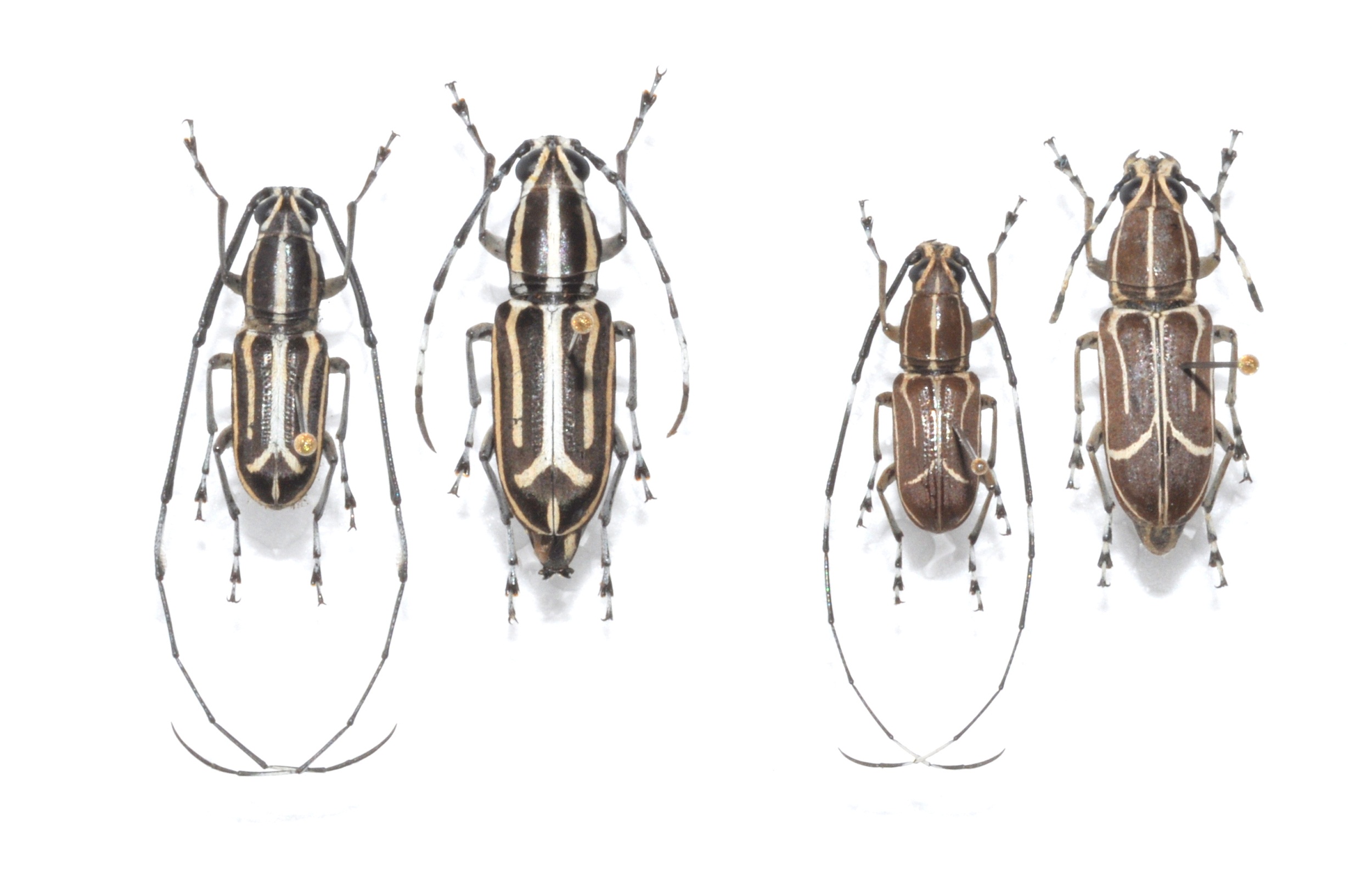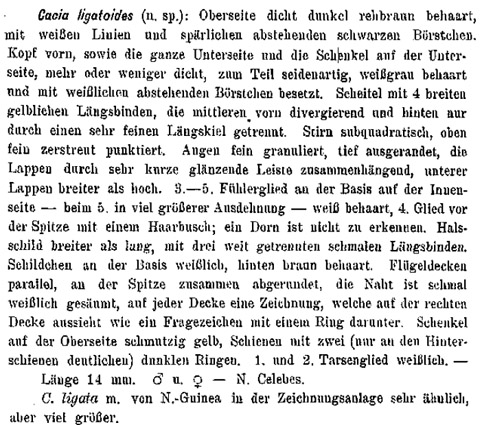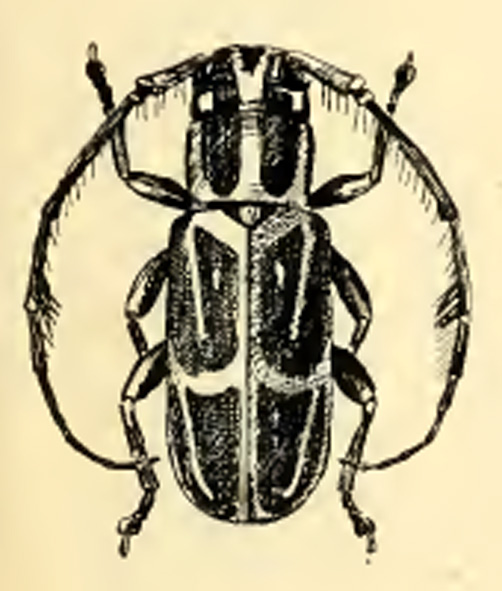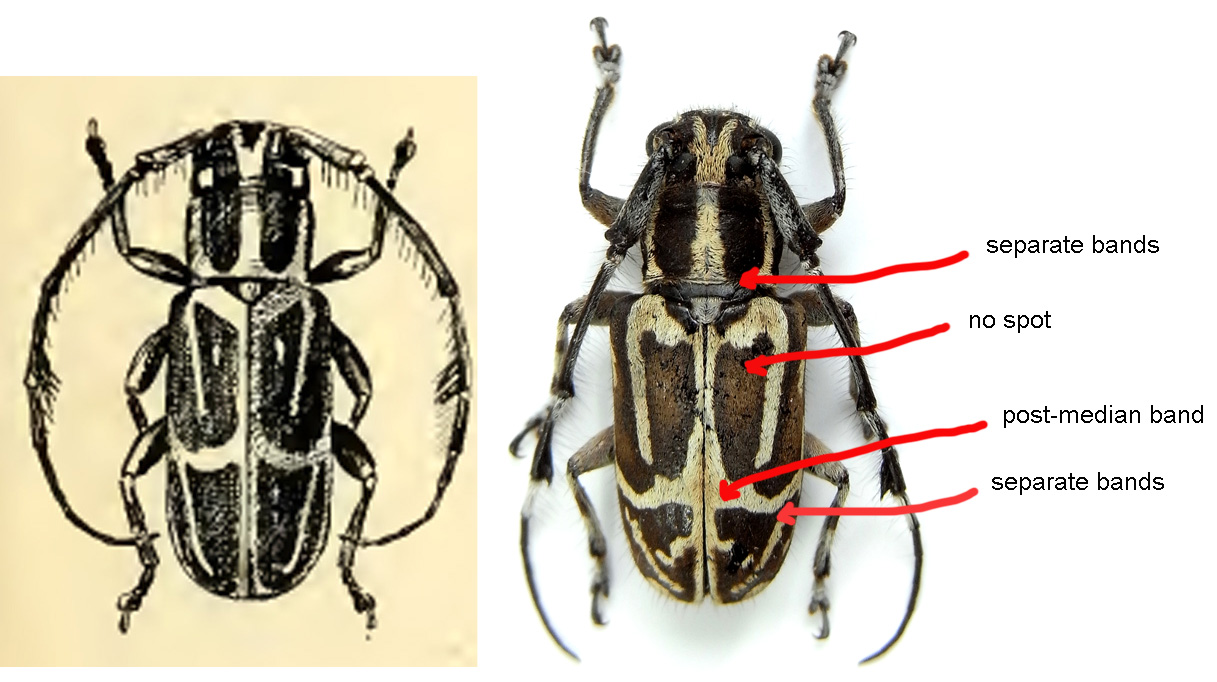| Author |
 Topic Topic  |
|
|
Vitali
Member Rosenbergia
   
Estonia
1016 Posts |
 Posted - 13/02/2011 : 20:50:48 Posted - 13/02/2011 : 20:50:48



|

The pattern reminds C. interrupteovittata, but this beetle comes from Sulawesi, Indonesia.
This species completes Cacia invasion here at Forum. |
Edited by - Xavier on 25/01/2021 07:42:59 |
|
|
Francesco
Forum Admin
    
Luxembourg
9627 Posts |
 Posted - 14/02/2011 : 09:58:57 Posted - 14/02/2011 : 09:58:57




|
Cacia (Corethrophora) vanikorensis Boisduval, 1835, a very characteristic species that Boisduval described from unknown locality.
He was uncertain among Vanikoro (Solomon Is.), New Guinea or Sulawesi. .. but he selected a wrong name, since this species is endemic from Sulawesi  |
 |
|
|
Pierre
Member Rosenbergia
   
Switzerland
1800 Posts |
 Posted - 17/02/2011 : 07:15:06 Posted - 17/02/2011 : 07:15:06



|

Totally out of topic, but fascinating though: what a stunning convergence with the colouration of eastern Asian Anthribidae!
Genus Xenocerus. |
 |
|
|
Francesco
Forum Admin
    
Luxembourg
9627 Posts |
 Posted - 17/02/2011 : 13:36:45 Posted - 17/02/2011 : 13:36:45




|
Very interesting topic!
According to me, this is the proof that insect colours can not be only explained by Batesian-Müllerian or cryptic mimicry.
This pattern has to nothing do with colour either of trees or of dangerous species... nonetheless, it is singularly similar in order to be considered a case.
My professor of zoology sustained that particular viruses could detach parts of the DNA from their hosts and insert them in the DNA of new hosts during the contagion. If these parts managed to codify pattern or other characteristics, this could explain because not philogenetically related animals have singularly similar structures. |
 |
|
|
Vitali
Member Rosenbergia
   
Estonia
1016 Posts |
 Posted - 17/02/2011 : 14:39:28 Posted - 17/02/2011 : 14:39:28



|
The latter explanation seems very attractive.
We learn a lot about mimicry of dangerous insects like wasps for instance, but it has been always fascinating to see Doliops mimicking Pachyrrhynchus. Is there any real profit for Doliops? It is hard to believe that only the hardness of Pachyrrhynchus' chitin is decisive in this case.
An absolutely stunning example of such mimicry can be seen at the ebay listing of 5 bugs now, where Doliops basilana is shown with the corresponding Pachyrrhynchus species (hurry to see, only 2 days to the end). |
 |
|
|
Xavier
Scientific Collaborator
    
France
12533 Posts |
 Posted - 20/11/2017 : 13:16:39 Posted - 20/11/2017 : 13:16:39



|

129.3 KB
Cacia (Corethrophora) vanikorensis (Boisduval, 1835)
This is the original drawing.
I do not think that Vitali species is the same. |
 |
|
|
Vitali
Member Rosenbergia
   
Estonia
1016 Posts |
 Posted - 21/11/2017 : 13:57:36 Posted - 21/11/2017 : 13:57:36



|
Does anyone have Schwarzer Bernhard, 1926, Beiträge zur Kenntnis der Cerambyciden (Col.). Entomologische Mitteilungen, Berlin 15 (1): 6-14, where C. ligatoides was described from Sulawesi?
That species was later recognized as a synonym of C. vanikorensis. |
 |
|
|
Xavier
Scientific Collaborator
    
France
12533 Posts |
 Posted - 21/11/2017 : 18:37:05 Posted - 21/11/2017 : 18:37:05



|

145.79 KB |
 |
|
|
Xavier
Scientific Collaborator
    
France
12533 Posts |
 Posted - 21/11/2017 : 19:07:38 Posted - 21/11/2017 : 19:07:38



|
I think your species is closer to this one described from Sulawesi :

104.27 KB
Cacia (Ipocregyes) monstrabilis Heller, 1916 HT |
 |
|
|
Vitali
Member Rosenbergia
   
Estonia
1016 Posts |
 Posted - 22/11/2017 : 08:50:37 Posted - 22/11/2017 : 08:50:37



|
Wow, Xavier! If you even haven't arrived at the destination, it is very close. Thank you.
Do you know how to distinguish Corethrophora from Ipocregyes?
By the way, there are photos of C. vanikorensis at Larry's site. These are really different. |
Edited by - Vitali on 22/11/2017 08:51:00 |
 |
|
|
Xavier
Scientific Collaborator
    
France
12533 Posts |
 Posted - 22/11/2017 : 12:24:42 Posted - 22/11/2017 : 12:24:42



|

26.62 KB
from Breuning(1939)
3rd antennomera large at the apex...Sub.gen. Corethrophora Blanch.
- 3rd antennomera no large or slightly enlarged et the apex....sub. gen. Ipocregyes Pasc. |
 |
|
|
Vitali
Member Rosenbergia
   
Estonia
1016 Posts |
 Posted - 22/11/2017 : 13:22:05 Posted - 22/11/2017 : 13:22:05



|
Yes, I also found this in Gressit’s Cerambycidae of China.
If so, there are several consequences:
1) my beetle should belong to Corethrophora (new comment: I am not sure anymore, as the thickness of the third antennomere is difficult to compare);
2) the second beetle shown for C. vanikorensis in Larry’s site presents a different species (new comment: this is C. ligata Schwarzer 1924);
3) according to the drawing C. monstrabilis Heller, 1916 should belong to Corethrophora (new comment: not sure, see 1).
Is the third antennomere thickened also in females?
|
Edited by - Vitali on 17/07/2019 18:39:59 |
 |
|
|
Xavier
Scientific Collaborator
    
France
12533 Posts |
 Posted - 28/12/2020 : 10:00:53 Posted - 28/12/2020 : 10:00:53



|
quote:
Originally posted by Vitali
Is the third antennomere thickened also in females?
I have a couple in collection of the same species, and yes, third antennomere is also thickened in female. |
Edited by - Xavier on 28/12/2020 10:01:39 |
 |
|
|
Vitali
Member Rosenbergia
   
Estonia
1016 Posts |
 Posted - 28/12/2020 : 11:02:32 Posted - 28/12/2020 : 11:02:32



|
| Hi, Xavier! Are you staying with Cacia (Ipocregyes) monstrabilis? |
 |
|
|
Xavier
Scientific Collaborator
    
France
12533 Posts |
 Posted - 28/12/2020 : 11:07:22 Posted - 28/12/2020 : 11:07:22



|
No...:

231.99 KB
Cacia (Ipocregyes) monstrabilis Heller, 1916 HT, Sulawesi, versus Cacia sp. female, South Sulawesi. |
Edited by - Xavier on 28/12/2020 11:58:58 |
 |
|
|
Xavier
Scientific Collaborator
    
France
12533 Posts |
 Posted - 25/01/2021 : 07:42:21 Posted - 25/01/2021 : 07:42:21



|
| I have seen specimens from Sulawesi with the longitudinal bands of the elytra very reduced or absent. I finally think that this species is very variable, and that it is indeed Cacia (Ipocregyes) monstrabilis Heller, 1916. |
 |
|
| |
 Topic Topic  |
|


